Analysis of Global Leadership: A Management Report Overview
VerifiedAdded on 2022/09/15
|11
|2444
|21
Report
AI Summary
This report provides a comprehensive analysis of global leadership, addressing critical questions related to leadership versus leader, follower-leader relationships, organizational culture, the role of diversity, effective negotiation, stakeholder responsibilities, and responsible global leadership. The report explores the advantages and disadvantages of global, local, and transnational approaches to corporate social responsibility (CSR), examining the challenges posed by emerging economies and the roadblocks faced by women in leadership. It emphasizes the importance of intercultural communication, the need for responsible leadership in a global stakeholder environment, and the ultimate mission of responsible global leadership, which includes delivering organizational and personal energy to achieve top-notch performance. The report concludes with recommendations for fostering effective global leadership, emphasizing empowerment, strong interpersonal skills, and a core set of values.
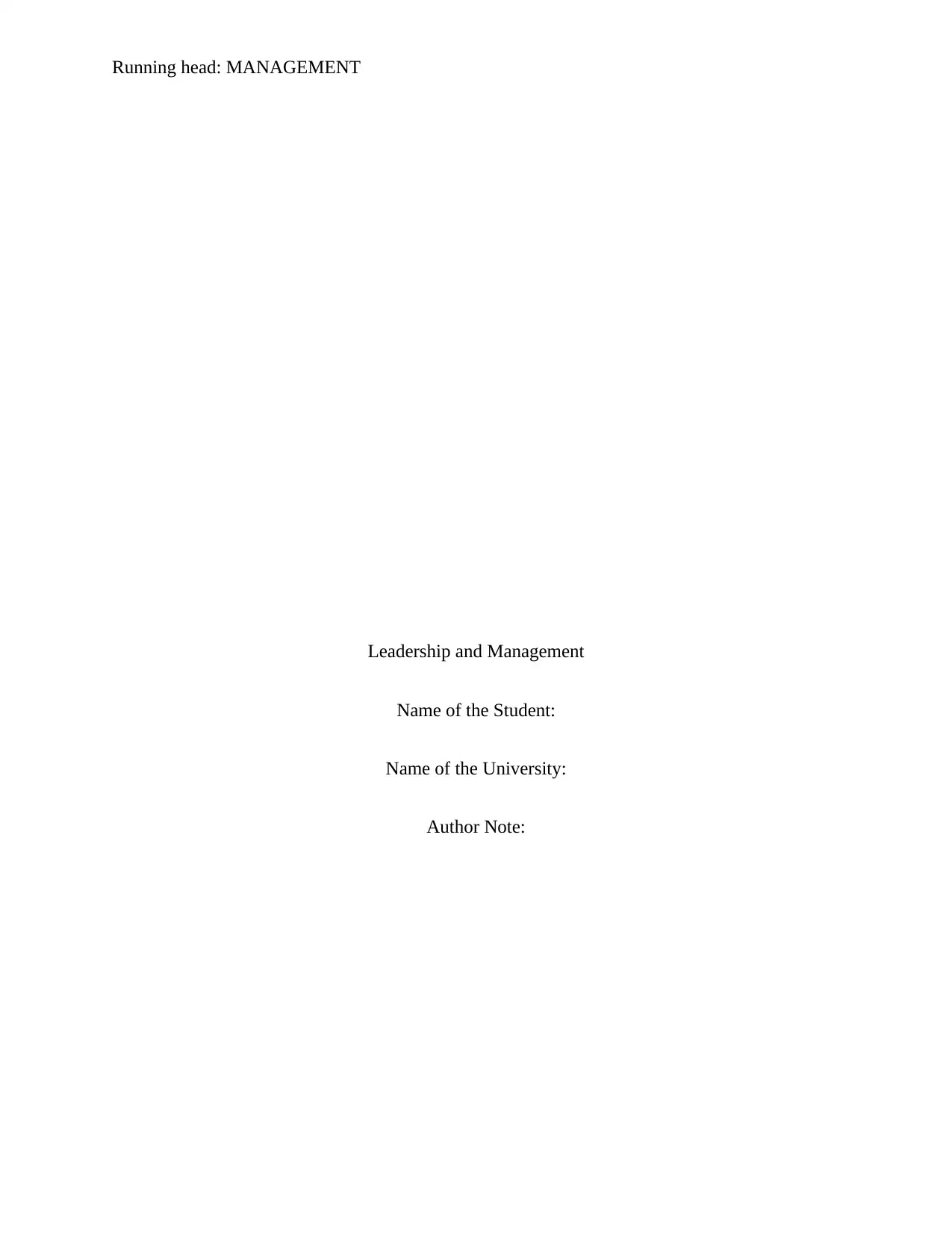
Running head: MANAGEMENT
Leadership and Management
Name of the Student:
Name of the University:
Author Note:
Leadership and Management
Name of the Student:
Name of the University:
Author Note:
Paraphrase This Document
Need a fresh take? Get an instant paraphrase of this document with our AI Paraphraser
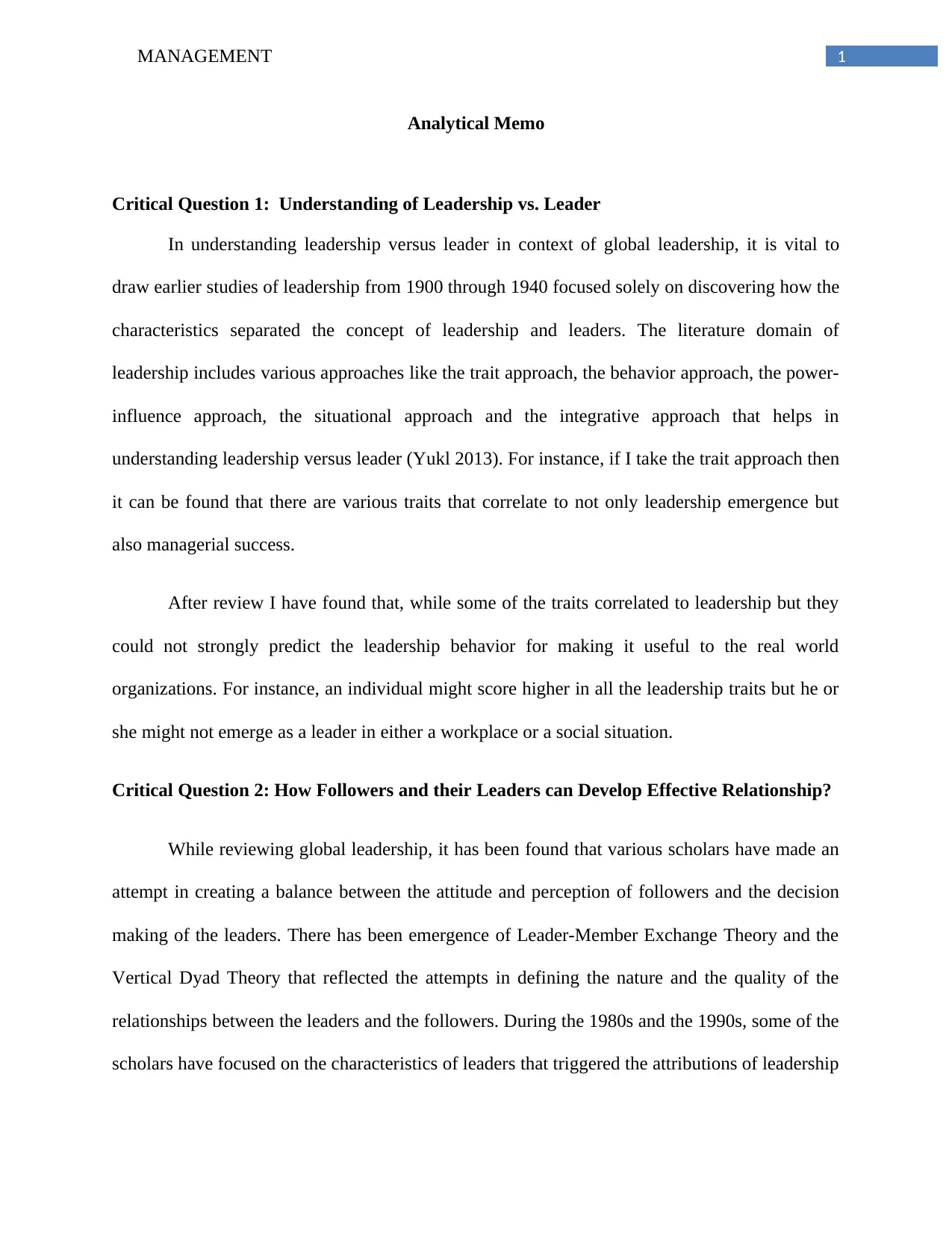
1MANAGEMENT
Analytical Memo
Critical Question 1: Understanding of Leadership vs. Leader
In understanding leadership versus leader in context of global leadership, it is vital to
draw earlier studies of leadership from 1900 through 1940 focused solely on discovering how the
characteristics separated the concept of leadership and leaders. The literature domain of
leadership includes various approaches like the trait approach, the behavior approach, the power-
influence approach, the situational approach and the integrative approach that helps in
understanding leadership versus leader (Yukl 2013). For instance, if I take the trait approach then
it can be found that there are various traits that correlate to not only leadership emergence but
also managerial success.
After review I have found that, while some of the traits correlated to leadership but they
could not strongly predict the leadership behavior for making it useful to the real world
organizations. For instance, an individual might score higher in all the leadership traits but he or
she might not emerge as a leader in either a workplace or a social situation.
Critical Question 2: How Followers and their Leaders can Develop Effective Relationship?
While reviewing global leadership, it has been found that various scholars have made an
attempt in creating a balance between the attitude and perception of followers and the decision
making of the leaders. There has been emergence of Leader-Member Exchange Theory and the
Vertical Dyad Theory that reflected the attempts in defining the nature and the quality of the
relationships between the leaders and the followers. During the 1980s and the 1990s, some of the
scholars have focused on the characteristics of leaders that triggered the attributions of leadership
Analytical Memo
Critical Question 1: Understanding of Leadership vs. Leader
In understanding leadership versus leader in context of global leadership, it is vital to
draw earlier studies of leadership from 1900 through 1940 focused solely on discovering how the
characteristics separated the concept of leadership and leaders. The literature domain of
leadership includes various approaches like the trait approach, the behavior approach, the power-
influence approach, the situational approach and the integrative approach that helps in
understanding leadership versus leader (Yukl 2013). For instance, if I take the trait approach then
it can be found that there are various traits that correlate to not only leadership emergence but
also managerial success.
After review I have found that, while some of the traits correlated to leadership but they
could not strongly predict the leadership behavior for making it useful to the real world
organizations. For instance, an individual might score higher in all the leadership traits but he or
she might not emerge as a leader in either a workplace or a social situation.
Critical Question 2: How Followers and their Leaders can Develop Effective Relationship?
While reviewing global leadership, it has been found that various scholars have made an
attempt in creating a balance between the attitude and perception of followers and the decision
making of the leaders. There has been emergence of Leader-Member Exchange Theory and the
Vertical Dyad Theory that reflected the attempts in defining the nature and the quality of the
relationships between the leaders and the followers. During the 1980s and the 1990s, some of the
scholars have focused on the characteristics of leaders that triggered the attributions of leadership
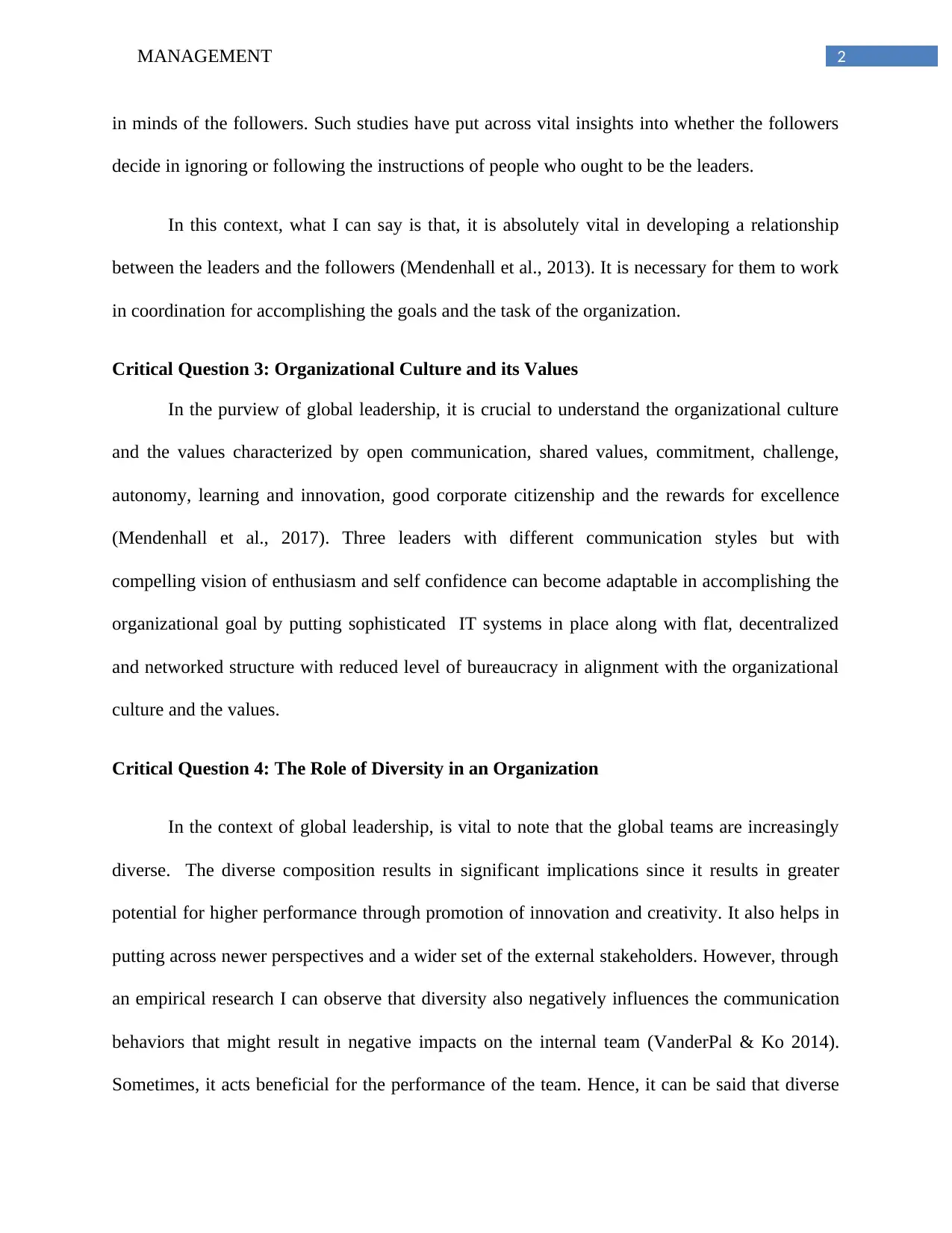
2MANAGEMENT
in minds of the followers. Such studies have put across vital insights into whether the followers
decide in ignoring or following the instructions of people who ought to be the leaders.
In this context, what I can say is that, it is absolutely vital in developing a relationship
between the leaders and the followers (Mendenhall et al., 2013). It is necessary for them to work
in coordination for accomplishing the goals and the task of the organization.
Critical Question 3: Organizational Culture and its Values
In the purview of global leadership, it is crucial to understand the organizational culture
and the values characterized by open communication, shared values, commitment, challenge,
autonomy, learning and innovation, good corporate citizenship and the rewards for excellence
(Mendenhall et al., 2017). Three leaders with different communication styles but with
compelling vision of enthusiasm and self confidence can become adaptable in accomplishing the
organizational goal by putting sophisticated IT systems in place along with flat, decentralized
and networked structure with reduced level of bureaucracy in alignment with the organizational
culture and the values.
Critical Question 4: The Role of Diversity in an Organization
In the context of global leadership, is vital to note that the global teams are increasingly
diverse. The diverse composition results in significant implications since it results in greater
potential for higher performance through promotion of innovation and creativity. It also helps in
putting across newer perspectives and a wider set of the external stakeholders. However, through
an empirical research I can observe that diversity also negatively influences the communication
behaviors that might result in negative impacts on the internal team (VanderPal & Ko 2014).
Sometimes, it acts beneficial for the performance of the team. Hence, it can be said that diverse
in minds of the followers. Such studies have put across vital insights into whether the followers
decide in ignoring or following the instructions of people who ought to be the leaders.
In this context, what I can say is that, it is absolutely vital in developing a relationship
between the leaders and the followers (Mendenhall et al., 2013). It is necessary for them to work
in coordination for accomplishing the goals and the task of the organization.
Critical Question 3: Organizational Culture and its Values
In the purview of global leadership, it is crucial to understand the organizational culture
and the values characterized by open communication, shared values, commitment, challenge,
autonomy, learning and innovation, good corporate citizenship and the rewards for excellence
(Mendenhall et al., 2017). Three leaders with different communication styles but with
compelling vision of enthusiasm and self confidence can become adaptable in accomplishing the
organizational goal by putting sophisticated IT systems in place along with flat, decentralized
and networked structure with reduced level of bureaucracy in alignment with the organizational
culture and the values.
Critical Question 4: The Role of Diversity in an Organization
In the context of global leadership, is vital to note that the global teams are increasingly
diverse. The diverse composition results in significant implications since it results in greater
potential for higher performance through promotion of innovation and creativity. It also helps in
putting across newer perspectives and a wider set of the external stakeholders. However, through
an empirical research I can observe that diversity also negatively influences the communication
behaviors that might result in negative impacts on the internal team (VanderPal & Ko 2014).
Sometimes, it acts beneficial for the performance of the team. Hence, it can be said that diverse
⊘ This is a preview!⊘
Do you want full access?
Subscribe today to unlock all pages.

Trusted by 1+ million students worldwide
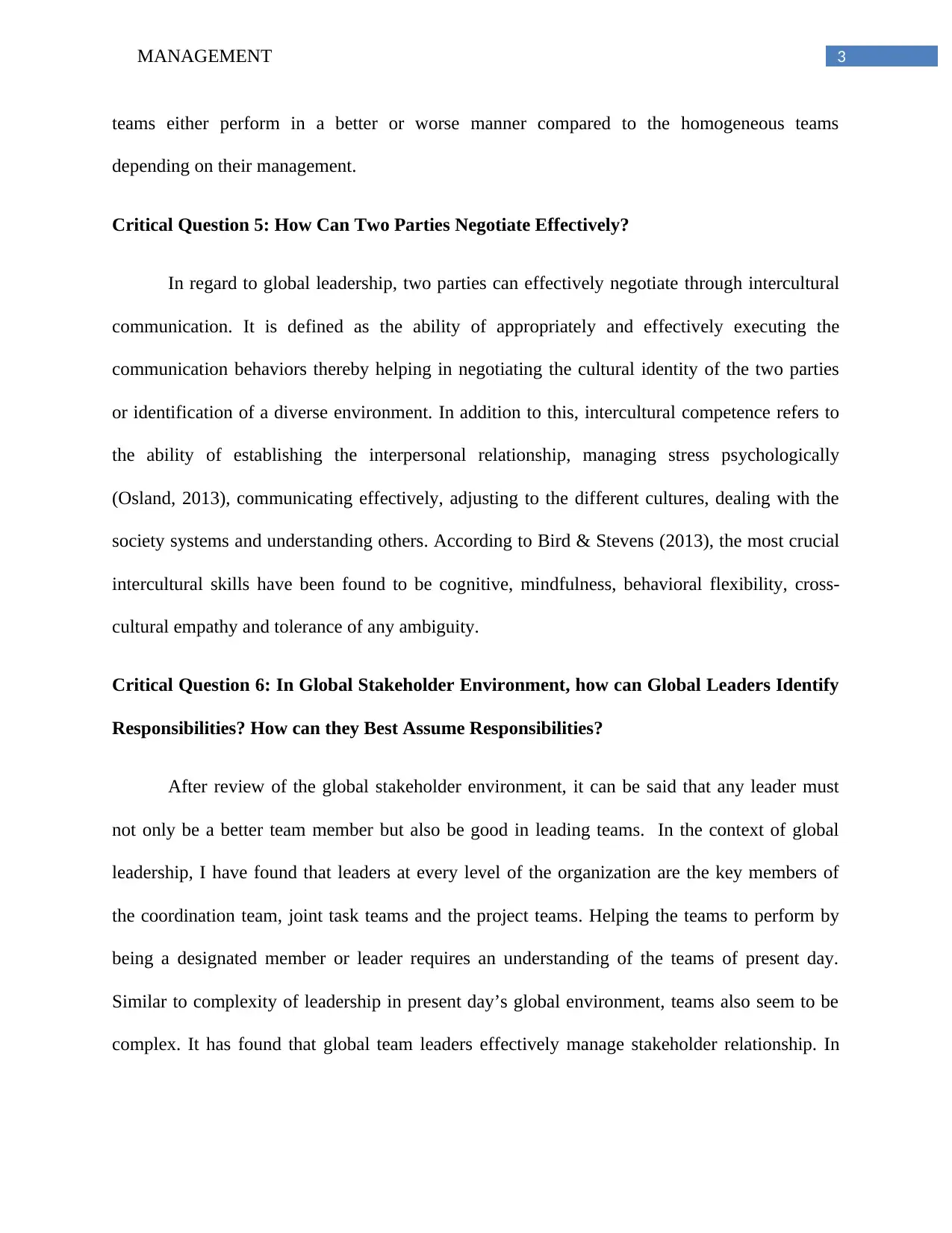
3MANAGEMENT
teams either perform in a better or worse manner compared to the homogeneous teams
depending on their management.
Critical Question 5: How Can Two Parties Negotiate Effectively?
In regard to global leadership, two parties can effectively negotiate through intercultural
communication. It is defined as the ability of appropriately and effectively executing the
communication behaviors thereby helping in negotiating the cultural identity of the two parties
or identification of a diverse environment. In addition to this, intercultural competence refers to
the ability of establishing the interpersonal relationship, managing stress psychologically
(Osland, 2013), communicating effectively, adjusting to the different cultures, dealing with the
society systems and understanding others. According to Bird & Stevens (2013), the most crucial
intercultural skills have been found to be cognitive, mindfulness, behavioral flexibility, cross-
cultural empathy and tolerance of any ambiguity.
Critical Question 6: In Global Stakeholder Environment, how can Global Leaders Identify
Responsibilities? How can they Best Assume Responsibilities?
After review of the global stakeholder environment, it can be said that any leader must
not only be a better team member but also be good in leading teams. In the context of global
leadership, I have found that leaders at every level of the organization are the key members of
the coordination team, joint task teams and the project teams. Helping the teams to perform by
being a designated member or leader requires an understanding of the teams of present day.
Similar to complexity of leadership in present day’s global environment, teams also seem to be
complex. It has found that global team leaders effectively manage stakeholder relationship. In
teams either perform in a better or worse manner compared to the homogeneous teams
depending on their management.
Critical Question 5: How Can Two Parties Negotiate Effectively?
In regard to global leadership, two parties can effectively negotiate through intercultural
communication. It is defined as the ability of appropriately and effectively executing the
communication behaviors thereby helping in negotiating the cultural identity of the two parties
or identification of a diverse environment. In addition to this, intercultural competence refers to
the ability of establishing the interpersonal relationship, managing stress psychologically
(Osland, 2013), communicating effectively, adjusting to the different cultures, dealing with the
society systems and understanding others. According to Bird & Stevens (2013), the most crucial
intercultural skills have been found to be cognitive, mindfulness, behavioral flexibility, cross-
cultural empathy and tolerance of any ambiguity.
Critical Question 6: In Global Stakeholder Environment, how can Global Leaders Identify
Responsibilities? How can they Best Assume Responsibilities?
After review of the global stakeholder environment, it can be said that any leader must
not only be a better team member but also be good in leading teams. In the context of global
leadership, I have found that leaders at every level of the organization are the key members of
the coordination team, joint task teams and the project teams. Helping the teams to perform by
being a designated member or leader requires an understanding of the teams of present day.
Similar to complexity of leadership in present day’s global environment, teams also seem to be
complex. It has found that global team leaders effectively manage stakeholder relationship. In
Paraphrase This Document
Need a fresh take? Get an instant paraphrase of this document with our AI Paraphraser
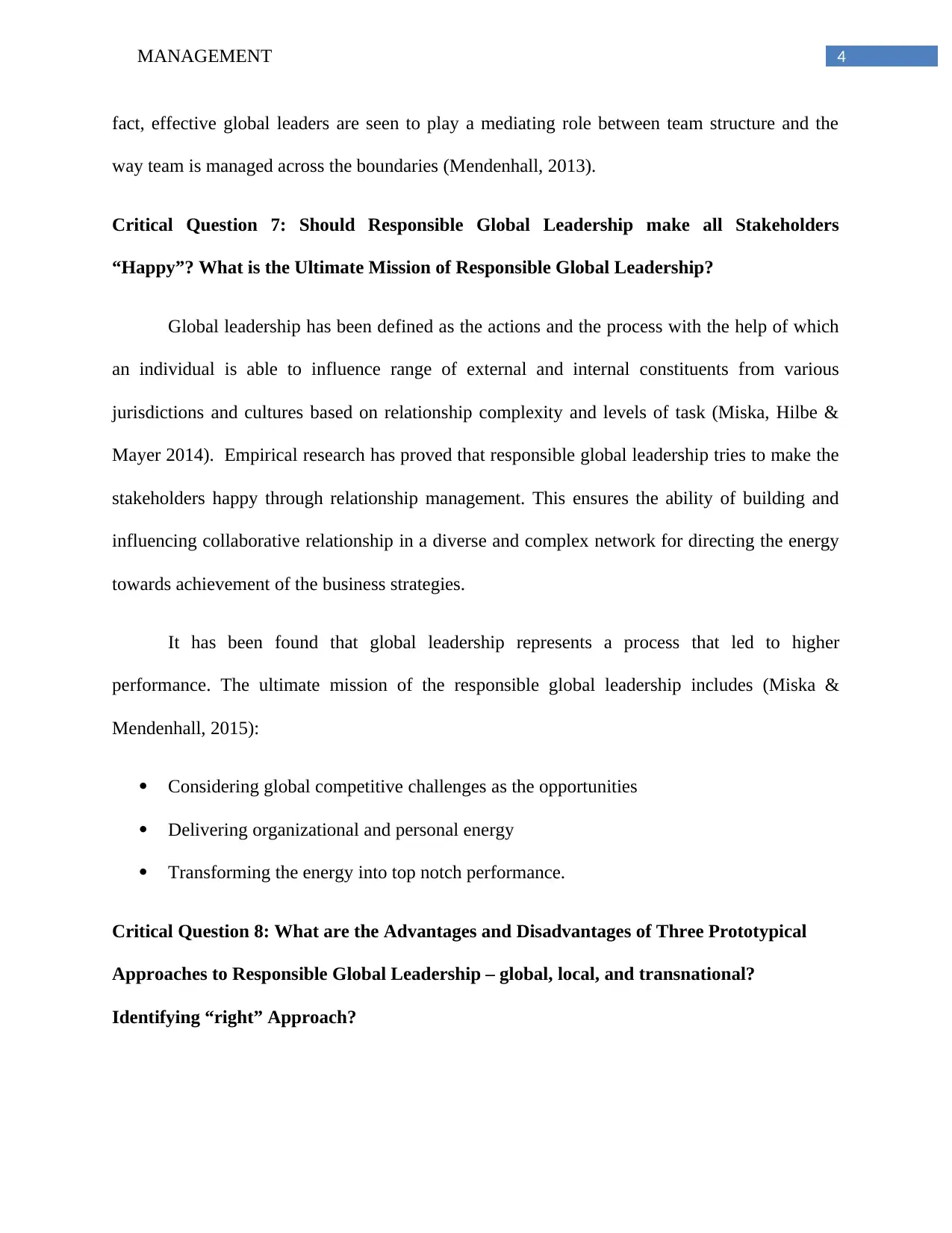
4MANAGEMENT
fact, effective global leaders are seen to play a mediating role between team structure and the
way team is managed across the boundaries (Mendenhall, 2013).
Critical Question 7: Should Responsible Global Leadership make all Stakeholders
“Happy”? What is the Ultimate Mission of Responsible Global Leadership?
Global leadership has been defined as the actions and the process with the help of which
an individual is able to influence range of external and internal constituents from various
jurisdictions and cultures based on relationship complexity and levels of task (Miska, Hilbe &
Mayer 2014). Empirical research has proved that responsible global leadership tries to make the
stakeholders happy through relationship management. This ensures the ability of building and
influencing collaborative relationship in a diverse and complex network for directing the energy
towards achievement of the business strategies.
It has been found that global leadership represents a process that led to higher
performance. The ultimate mission of the responsible global leadership includes (Miska &
Mendenhall, 2015):
Considering global competitive challenges as the opportunities
Delivering organizational and personal energy
Transforming the energy into top notch performance.
Critical Question 8: What are the Advantages and Disadvantages of Three Prototypical
Approaches to Responsible Global Leadership – global, local, and transnational?
Identifying “right” Approach?
fact, effective global leaders are seen to play a mediating role between team structure and the
way team is managed across the boundaries (Mendenhall, 2013).
Critical Question 7: Should Responsible Global Leadership make all Stakeholders
“Happy”? What is the Ultimate Mission of Responsible Global Leadership?
Global leadership has been defined as the actions and the process with the help of which
an individual is able to influence range of external and internal constituents from various
jurisdictions and cultures based on relationship complexity and levels of task (Miska, Hilbe &
Mayer 2014). Empirical research has proved that responsible global leadership tries to make the
stakeholders happy through relationship management. This ensures the ability of building and
influencing collaborative relationship in a diverse and complex network for directing the energy
towards achievement of the business strategies.
It has been found that global leadership represents a process that led to higher
performance. The ultimate mission of the responsible global leadership includes (Miska &
Mendenhall, 2015):
Considering global competitive challenges as the opportunities
Delivering organizational and personal energy
Transforming the energy into top notch performance.
Critical Question 8: What are the Advantages and Disadvantages of Three Prototypical
Approaches to Responsible Global Leadership – global, local, and transnational?
Identifying “right” Approach?
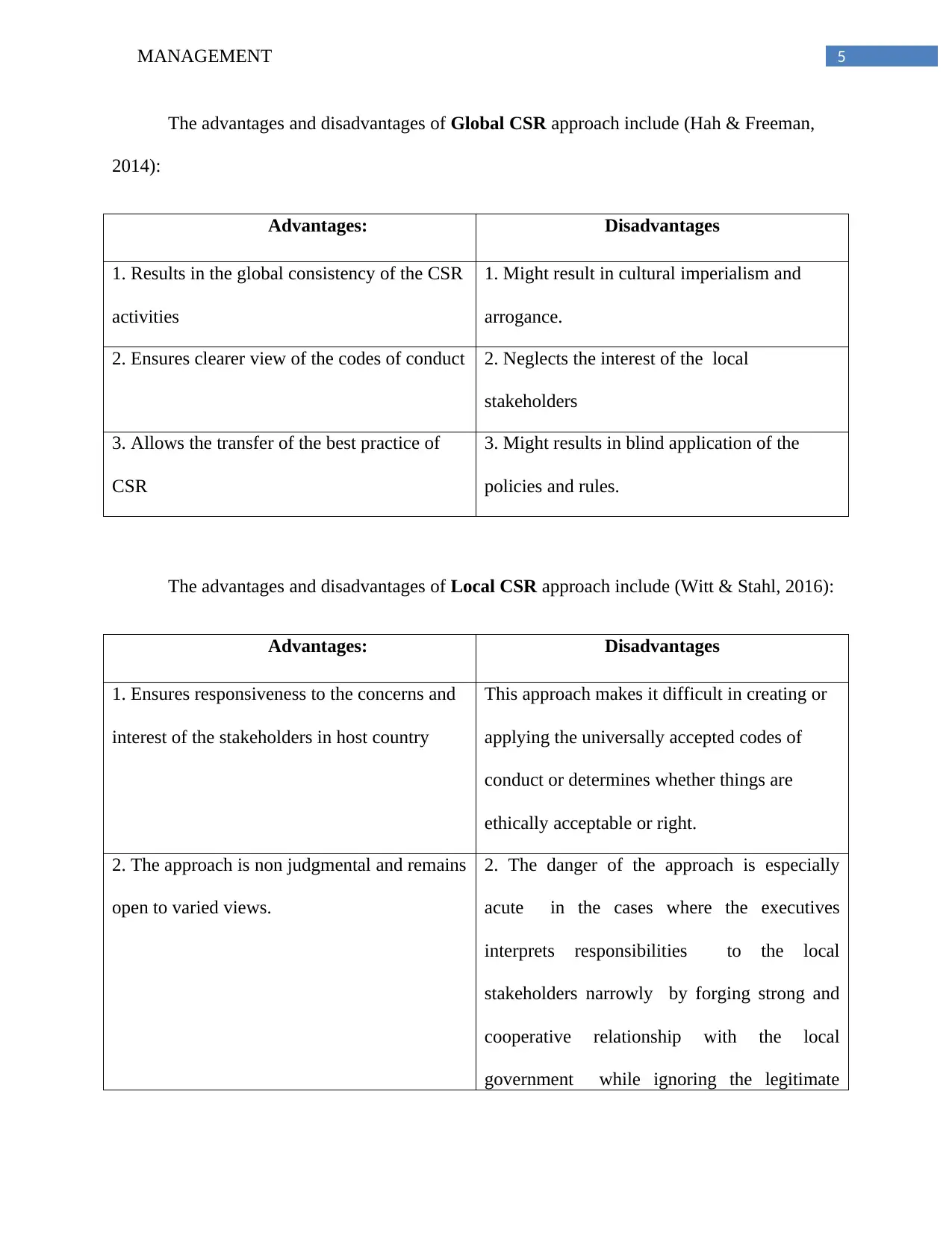
5MANAGEMENT
The advantages and disadvantages of Global CSR approach include (Hah & Freeman,
2014):
Advantages: Disadvantages
1. Results in the global consistency of the CSR
activities
1. Might result in cultural imperialism and
arrogance.
2. Ensures clearer view of the codes of conduct 2. Neglects the interest of the local
stakeholders
3. Allows the transfer of the best practice of
CSR
3. Might results in blind application of the
policies and rules.
The advantages and disadvantages of Local CSR approach include (Witt & Stahl, 2016):
Advantages: Disadvantages
1. Ensures responsiveness to the concerns and
interest of the stakeholders in host country
This approach makes it difficult in creating or
applying the universally accepted codes of
conduct or determines whether things are
ethically acceptable or right.
2. The approach is non judgmental and remains
open to varied views.
2. The danger of the approach is especially
acute in the cases where the executives
interprets responsibilities to the local
stakeholders narrowly by forging strong and
cooperative relationship with the local
government while ignoring the legitimate
The advantages and disadvantages of Global CSR approach include (Hah & Freeman,
2014):
Advantages: Disadvantages
1. Results in the global consistency of the CSR
activities
1. Might result in cultural imperialism and
arrogance.
2. Ensures clearer view of the codes of conduct 2. Neglects the interest of the local
stakeholders
3. Allows the transfer of the best practice of
CSR
3. Might results in blind application of the
policies and rules.
The advantages and disadvantages of Local CSR approach include (Witt & Stahl, 2016):
Advantages: Disadvantages
1. Ensures responsiveness to the concerns and
interest of the stakeholders in host country
This approach makes it difficult in creating or
applying the universally accepted codes of
conduct or determines whether things are
ethically acceptable or right.
2. The approach is non judgmental and remains
open to varied views.
2. The danger of the approach is especially
acute in the cases where the executives
interprets responsibilities to the local
stakeholders narrowly by forging strong and
cooperative relationship with the local
government while ignoring the legitimate
⊘ This is a preview!⊘
Do you want full access?
Subscribe today to unlock all pages.

Trusted by 1+ million students worldwide
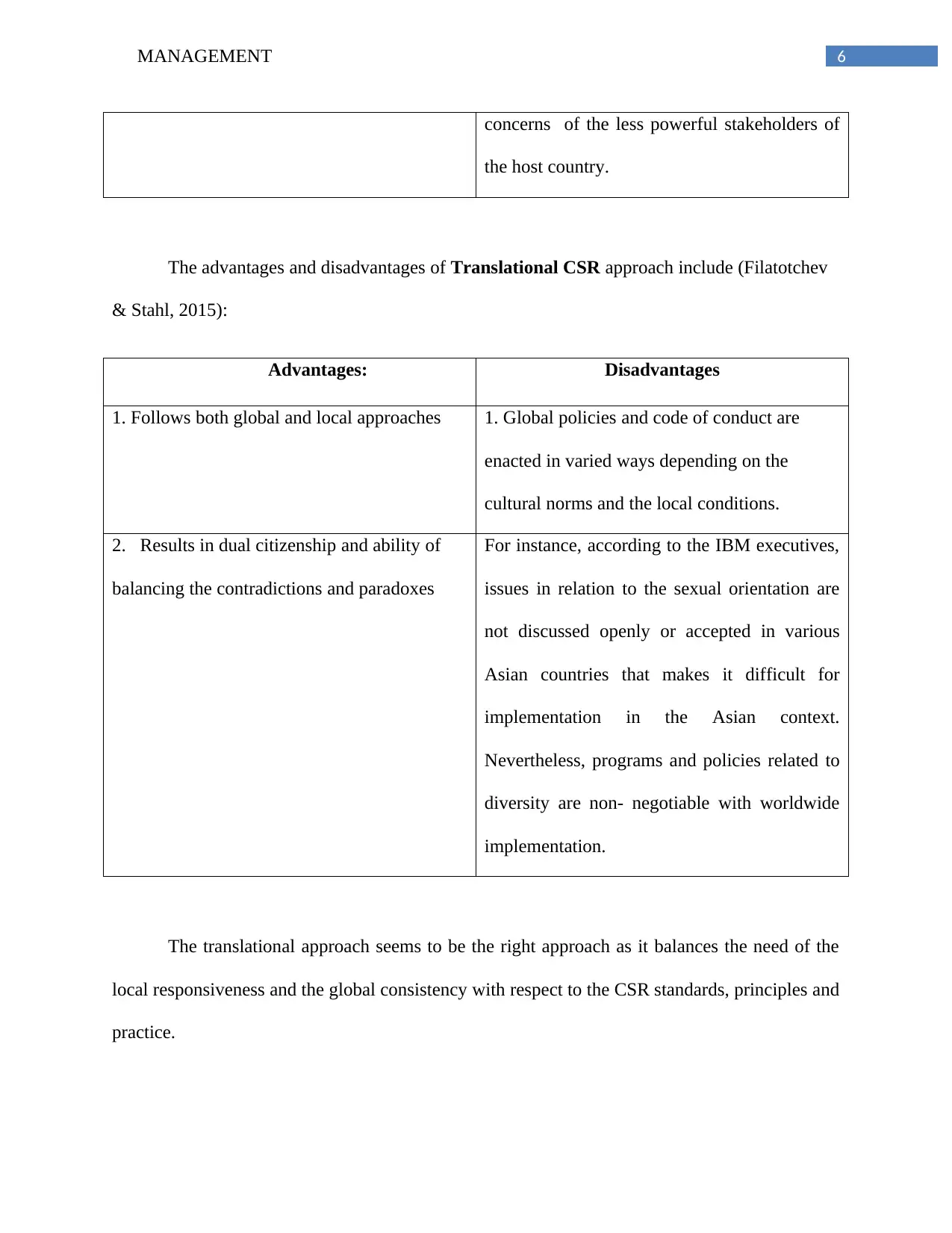
6MANAGEMENT
concerns of the less powerful stakeholders of
the host country.
The advantages and disadvantages of Translational CSR approach include (Filatotchev
& Stahl, 2015):
Advantages: Disadvantages
1. Follows both global and local approaches 1. Global policies and code of conduct are
enacted in varied ways depending on the
cultural norms and the local conditions.
2. Results in dual citizenship and ability of
balancing the contradictions and paradoxes
For instance, according to the IBM executives,
issues in relation to the sexual orientation are
not discussed openly or accepted in various
Asian countries that makes it difficult for
implementation in the Asian context.
Nevertheless, programs and policies related to
diversity are non- negotiable with worldwide
implementation.
The translational approach seems to be the right approach as it balances the need of the
local responsiveness and the global consistency with respect to the CSR standards, principles and
practice.
concerns of the less powerful stakeholders of
the host country.
The advantages and disadvantages of Translational CSR approach include (Filatotchev
& Stahl, 2015):
Advantages: Disadvantages
1. Follows both global and local approaches 1. Global policies and code of conduct are
enacted in varied ways depending on the
cultural norms and the local conditions.
2. Results in dual citizenship and ability of
balancing the contradictions and paradoxes
For instance, according to the IBM executives,
issues in relation to the sexual orientation are
not discussed openly or accepted in various
Asian countries that makes it difficult for
implementation in the Asian context.
Nevertheless, programs and policies related to
diversity are non- negotiable with worldwide
implementation.
The translational approach seems to be the right approach as it balances the need of the
local responsiveness and the global consistency with respect to the CSR standards, principles and
practice.
Paraphrase This Document
Need a fresh take? Get an instant paraphrase of this document with our AI Paraphraser
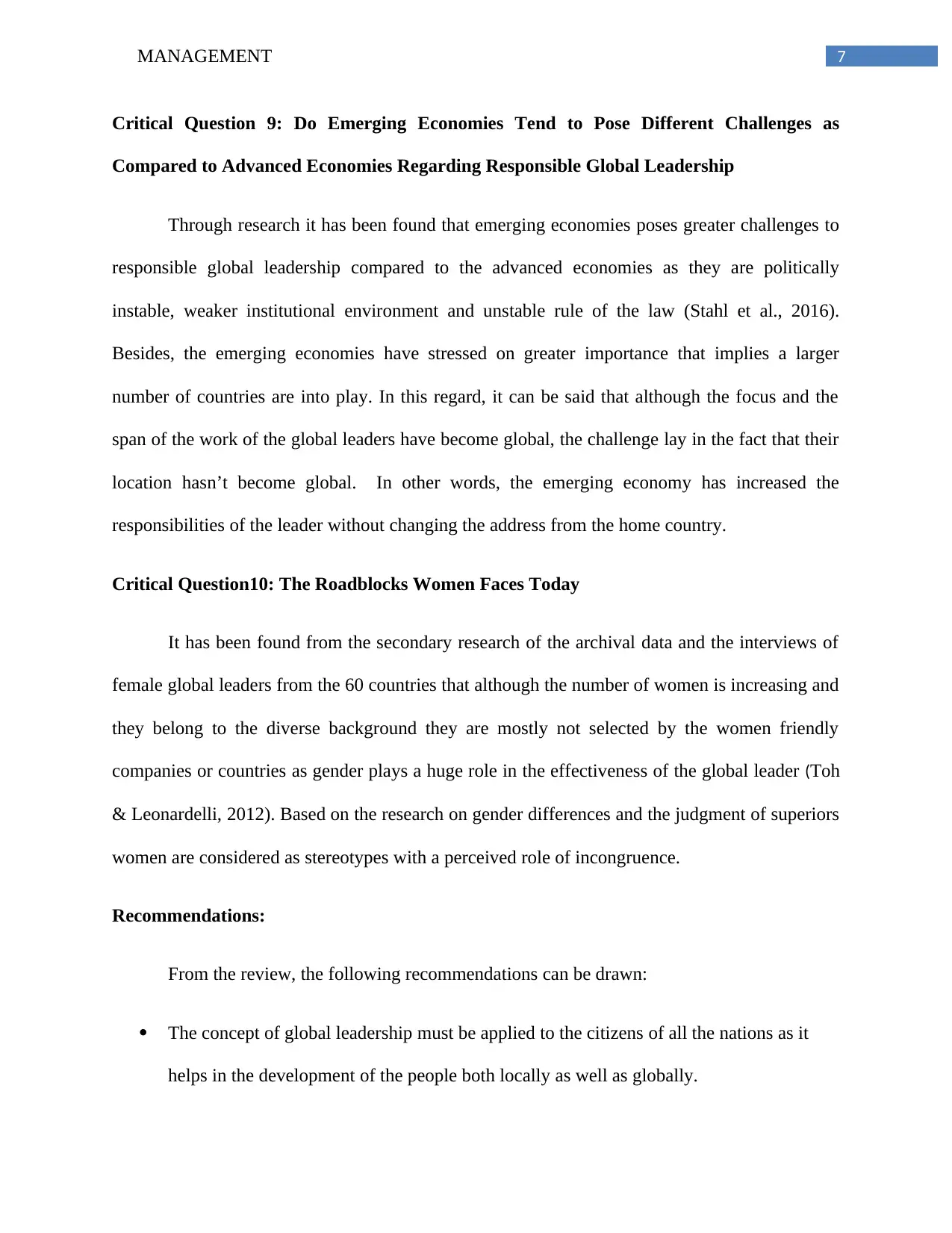
7MANAGEMENT
Critical Question 9: Do Emerging Economies Tend to Pose Different Challenges as
Compared to Advanced Economies Regarding Responsible Global Leadership
Through research it has been found that emerging economies poses greater challenges to
responsible global leadership compared to the advanced economies as they are politically
instable, weaker institutional environment and unstable rule of the law (Stahl et al., 2016).
Besides, the emerging economies have stressed on greater importance that implies a larger
number of countries are into play. In this regard, it can be said that although the focus and the
span of the work of the global leaders have become global, the challenge lay in the fact that their
location hasn’t become global. In other words, the emerging economy has increased the
responsibilities of the leader without changing the address from the home country.
Critical Question10: The Roadblocks Women Faces Today
It has been found from the secondary research of the archival data and the interviews of
female global leaders from the 60 countries that although the number of women is increasing and
they belong to the diverse background they are mostly not selected by the women friendly
companies or countries as gender plays a huge role in the effectiveness of the global leader (Toh
& Leonardelli, 2012). Based on the research on gender differences and the judgment of superiors
women are considered as stereotypes with a perceived role of incongruence.
Recommendations:
From the review, the following recommendations can be drawn:
The concept of global leadership must be applied to the citizens of all the nations as it
helps in the development of the people both locally as well as globally.
Critical Question 9: Do Emerging Economies Tend to Pose Different Challenges as
Compared to Advanced Economies Regarding Responsible Global Leadership
Through research it has been found that emerging economies poses greater challenges to
responsible global leadership compared to the advanced economies as they are politically
instable, weaker institutional environment and unstable rule of the law (Stahl et al., 2016).
Besides, the emerging economies have stressed on greater importance that implies a larger
number of countries are into play. In this regard, it can be said that although the focus and the
span of the work of the global leaders have become global, the challenge lay in the fact that their
location hasn’t become global. In other words, the emerging economy has increased the
responsibilities of the leader without changing the address from the home country.
Critical Question10: The Roadblocks Women Faces Today
It has been found from the secondary research of the archival data and the interviews of
female global leaders from the 60 countries that although the number of women is increasing and
they belong to the diverse background they are mostly not selected by the women friendly
companies or countries as gender plays a huge role in the effectiveness of the global leader (Toh
& Leonardelli, 2012). Based on the research on gender differences and the judgment of superiors
women are considered as stereotypes with a perceived role of incongruence.
Recommendations:
From the review, the following recommendations can be drawn:
The concept of global leadership must be applied to the citizens of all the nations as it
helps in the development of the people both locally as well as globally.
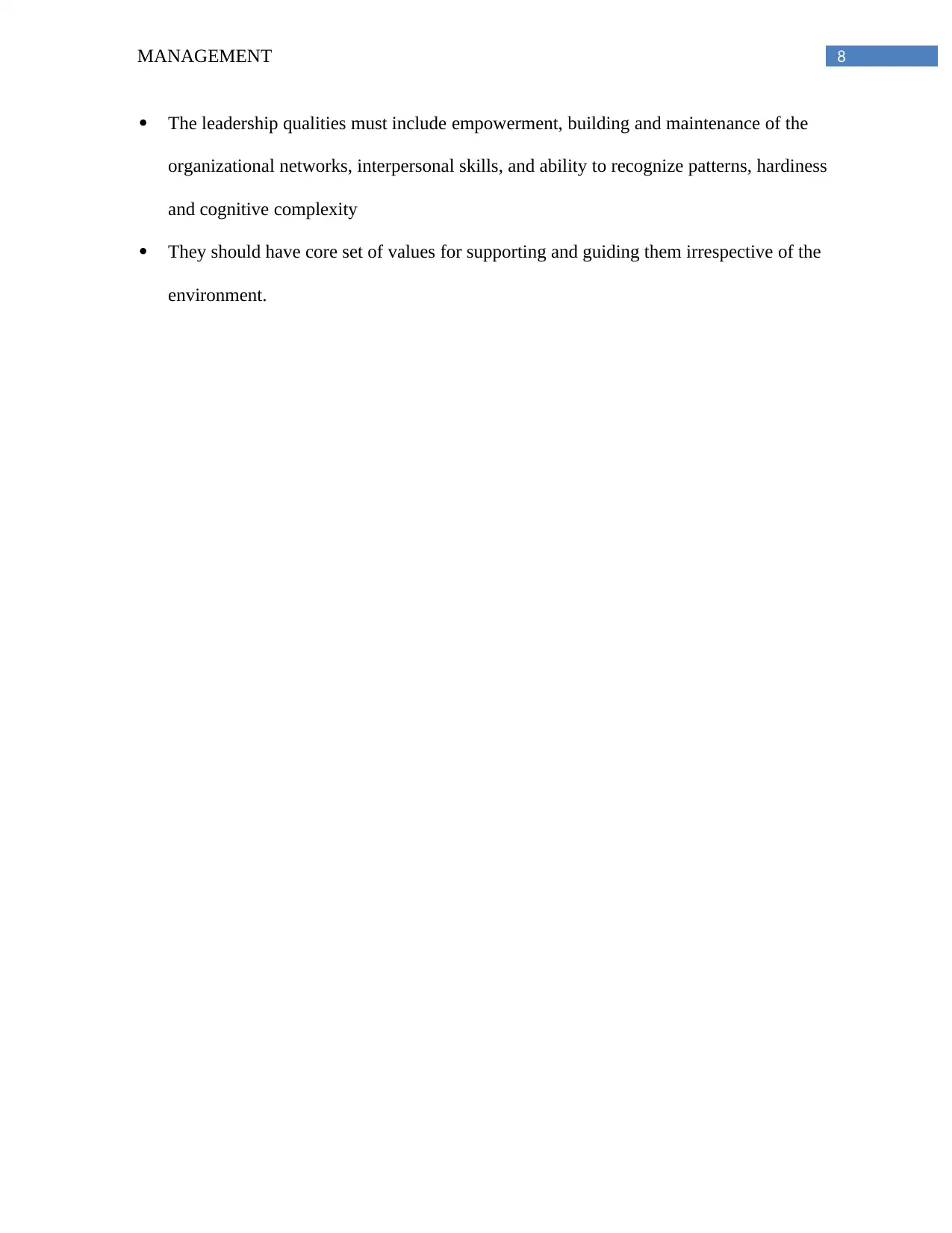
8MANAGEMENT
The leadership qualities must include empowerment, building and maintenance of the
organizational networks, interpersonal skills, and ability to recognize patterns, hardiness
and cognitive complexity
They should have core set of values for supporting and guiding them irrespective of the
environment.
The leadership qualities must include empowerment, building and maintenance of the
organizational networks, interpersonal skills, and ability to recognize patterns, hardiness
and cognitive complexity
They should have core set of values for supporting and guiding them irrespective of the
environment.
⊘ This is a preview!⊘
Do you want full access?
Subscribe today to unlock all pages.

Trusted by 1+ million students worldwide
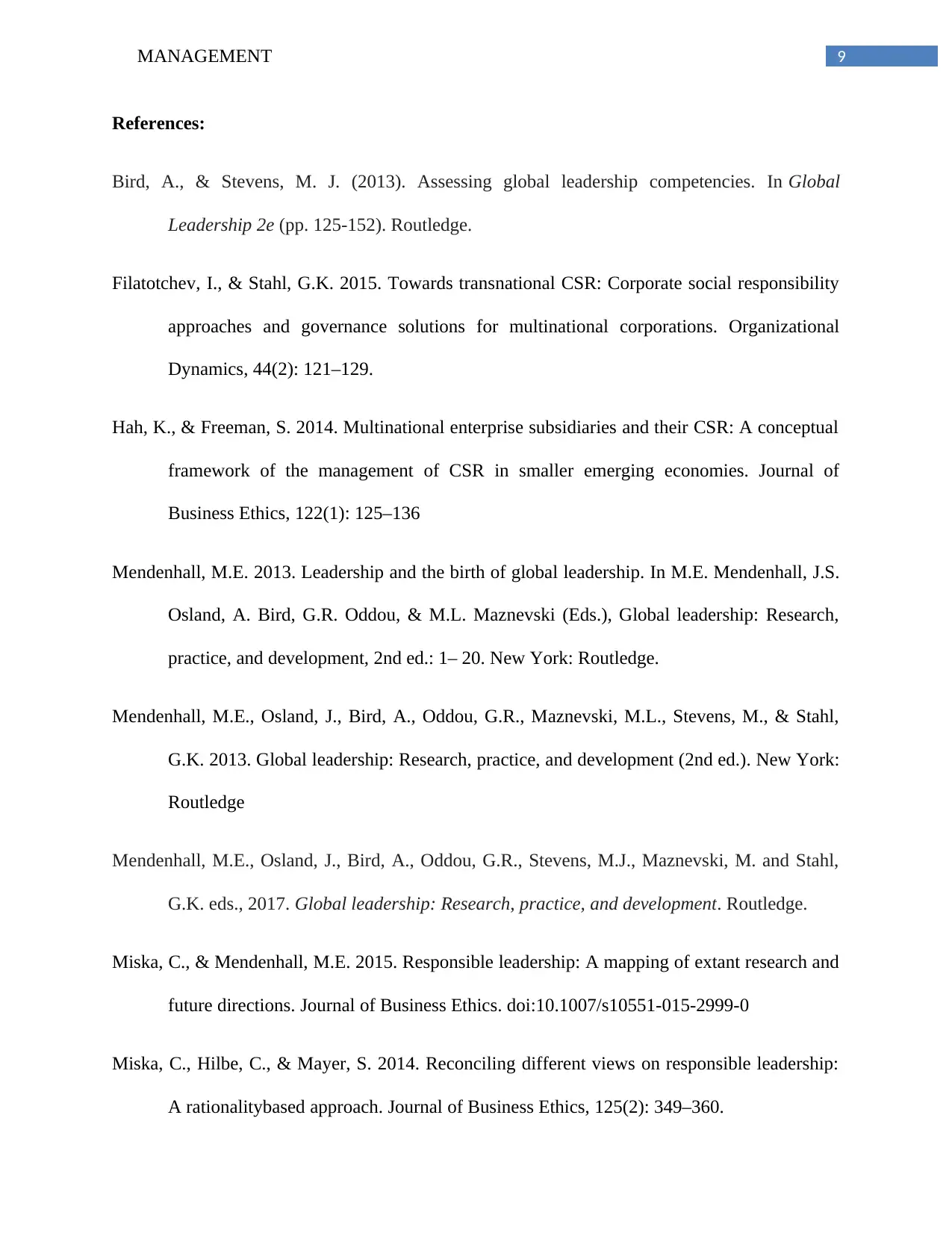
9MANAGEMENT
References:
Bird, A., & Stevens, M. J. (2013). Assessing global leadership competencies. In Global
Leadership 2e (pp. 125-152). Routledge.
Filatotchev, I., & Stahl, G.K. 2015. Towards transnational CSR: Corporate social responsibility
approaches and governance solutions for multinational corporations. Organizational
Dynamics, 44(2): 121–129.
Hah, K., & Freeman, S. 2014. Multinational enterprise subsidiaries and their CSR: A conceptual
framework of the management of CSR in smaller emerging economies. Journal of
Business Ethics, 122(1): 125–136
Mendenhall, M.E. 2013. Leadership and the birth of global leadership. In M.E. Mendenhall, J.S.
Osland, A. Bird, G.R. Oddou, & M.L. Maznevski (Eds.), Global leadership: Research,
practice, and development, 2nd ed.: 1– 20. New York: Routledge.
Mendenhall, M.E., Osland, J., Bird, A., Oddou, G.R., Maznevski, M.L., Stevens, M., & Stahl,
G.K. 2013. Global leadership: Research, practice, and development (2nd ed.). New York:
Routledge
Mendenhall, M.E., Osland, J., Bird, A., Oddou, G.R., Stevens, M.J., Maznevski, M. and Stahl,
G.K. eds., 2017. Global leadership: Research, practice, and development. Routledge.
Miska, C., & Mendenhall, M.E. 2015. Responsible leadership: A mapping of extant research and
future directions. Journal of Business Ethics. doi:10.1007/s10551-015-2999-0
Miska, C., Hilbe, C., & Mayer, S. 2014. Reconciling different views on responsible leadership:
A rationalitybased approach. Journal of Business Ethics, 125(2): 349–360.
References:
Bird, A., & Stevens, M. J. (2013). Assessing global leadership competencies. In Global
Leadership 2e (pp. 125-152). Routledge.
Filatotchev, I., & Stahl, G.K. 2015. Towards transnational CSR: Corporate social responsibility
approaches and governance solutions for multinational corporations. Organizational
Dynamics, 44(2): 121–129.
Hah, K., & Freeman, S. 2014. Multinational enterprise subsidiaries and their CSR: A conceptual
framework of the management of CSR in smaller emerging economies. Journal of
Business Ethics, 122(1): 125–136
Mendenhall, M.E. 2013. Leadership and the birth of global leadership. In M.E. Mendenhall, J.S.
Osland, A. Bird, G.R. Oddou, & M.L. Maznevski (Eds.), Global leadership: Research,
practice, and development, 2nd ed.: 1– 20. New York: Routledge.
Mendenhall, M.E., Osland, J., Bird, A., Oddou, G.R., Maznevski, M.L., Stevens, M., & Stahl,
G.K. 2013. Global leadership: Research, practice, and development (2nd ed.). New York:
Routledge
Mendenhall, M.E., Osland, J., Bird, A., Oddou, G.R., Stevens, M.J., Maznevski, M. and Stahl,
G.K. eds., 2017. Global leadership: Research, practice, and development. Routledge.
Miska, C., & Mendenhall, M.E. 2015. Responsible leadership: A mapping of extant research and
future directions. Journal of Business Ethics. doi:10.1007/s10551-015-2999-0
Miska, C., Hilbe, C., & Mayer, S. 2014. Reconciling different views on responsible leadership:
A rationalitybased approach. Journal of Business Ethics, 125(2): 349–360.
Paraphrase This Document
Need a fresh take? Get an instant paraphrase of this document with our AI Paraphraser
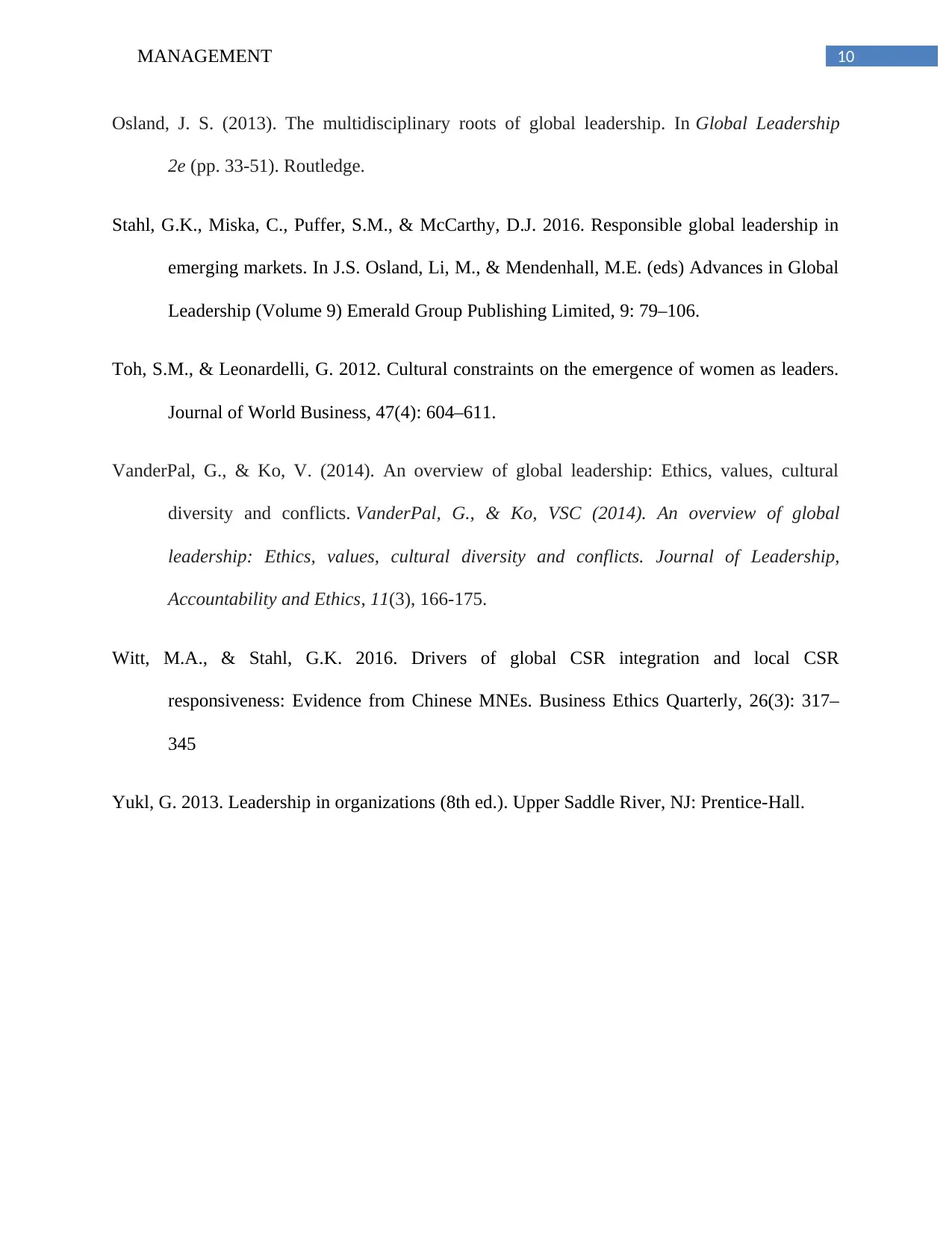
10MANAGEMENT
Osland, J. S. (2013). The multidisciplinary roots of global leadership. In Global Leadership
2e (pp. 33-51). Routledge.
Stahl, G.K., Miska, C., Puffer, S.M., & McCarthy, D.J. 2016. Responsible global leadership in
emerging markets. In J.S. Osland, Li, M., & Mendenhall, M.E. (eds) Advances in Global
Leadership (Volume 9) Emerald Group Publishing Limited, 9: 79–106.
Toh, S.M., & Leonardelli, G. 2012. Cultural constraints on the emergence of women as leaders.
Journal of World Business, 47(4): 604–611.
VanderPal, G., & Ko, V. (2014). An overview of global leadership: Ethics, values, cultural
diversity and conflicts. VanderPal, G., & Ko, VSC (2014). An overview of global
leadership: Ethics, values, cultural diversity and conflicts. Journal of Leadership,
Accountability and Ethics, 11(3), 166-175.
Witt, M.A., & Stahl, G.K. 2016. Drivers of global CSR integration and local CSR
responsiveness: Evidence from Chinese MNEs. Business Ethics Quarterly, 26(3): 317–
345
Yukl, G. 2013. Leadership in organizations (8th ed.). Upper Saddle River, NJ: Prentice-Hall.
Osland, J. S. (2013). The multidisciplinary roots of global leadership. In Global Leadership
2e (pp. 33-51). Routledge.
Stahl, G.K., Miska, C., Puffer, S.M., & McCarthy, D.J. 2016. Responsible global leadership in
emerging markets. In J.S. Osland, Li, M., & Mendenhall, M.E. (eds) Advances in Global
Leadership (Volume 9) Emerald Group Publishing Limited, 9: 79–106.
Toh, S.M., & Leonardelli, G. 2012. Cultural constraints on the emergence of women as leaders.
Journal of World Business, 47(4): 604–611.
VanderPal, G., & Ko, V. (2014). An overview of global leadership: Ethics, values, cultural
diversity and conflicts. VanderPal, G., & Ko, VSC (2014). An overview of global
leadership: Ethics, values, cultural diversity and conflicts. Journal of Leadership,
Accountability and Ethics, 11(3), 166-175.
Witt, M.A., & Stahl, G.K. 2016. Drivers of global CSR integration and local CSR
responsiveness: Evidence from Chinese MNEs. Business Ethics Quarterly, 26(3): 317–
345
Yukl, G. 2013. Leadership in organizations (8th ed.). Upper Saddle River, NJ: Prentice-Hall.
1 out of 11
Related Documents
Your All-in-One AI-Powered Toolkit for Academic Success.
+13062052269
info@desklib.com
Available 24*7 on WhatsApp / Email
![[object Object]](/_next/static/media/star-bottom.7253800d.svg)
Unlock your academic potential
Copyright © 2020–2025 A2Z Services. All Rights Reserved. Developed and managed by ZUCOL.




